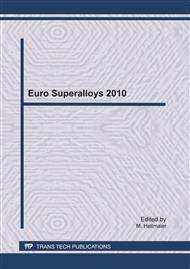[1]
C.T. Sims, N.S. Stolokoff and W.C. Hagel, John Wiley & Sons, (1987).
Google Scholar
[2]
R.J. Mitchell, M. Preuss and M.J. Hardy, Met. Trans. A, 38a, (2007), 615-627.
Google Scholar
[3]
R.J. Mitchell, M. Preuss, M.J. Hardy and S. Tin, Mater. Sci. Eng. A, 423, (2006), 282-291.
Google Scholar
[4]
R.J. Mitchell, M. Preuss, S. Tin and M.C. Hardy, Mater. Sci. Eng. A, 473, (2008), 158-165.
Google Scholar
[5]
J. LI and R.P. WAHI, Acta metall. Mater., 43, 2, (1995), 507-517.
Google Scholar
[6]
R.C. Reed, Cambridge Univeristy Press, (2006).
Google Scholar
[7]
N. S. Stoloff, John Wiley & Sons, (1987), 61-96.
Google Scholar
[8]
M. Preuss, J. Quinta da Fonseca, B. Grant, E. Knoche, R. Moat and M. Daymond, (2008).
Google Scholar
[9]
M. P. Jackson and R. C. Reed, Materials Science and Engineering A, 259, 1, (1999), 85-97.
Google Scholar
[10]
M. R. Daymond, M. Preuss and B. Clausen, Acta Materialia, 55, 9, (2007), 3089-3102.
Google Scholar
[11]
S.J. Hessell, W. Voice, A.W. James, S.A. Blackham, C.J. Small and M.R. Winstone, (1999).
Google Scholar
[12]
M.C. Hardy, B. Zirbel, G. Shen and R. Shankar, (2004), 83-90.
Google Scholar
[13]
F. Torster, G. Baumeister, J. Albrecht, G. Lutjering, D. Helm and M.A. Daeubler, Mater. Sci. Eng. A, (1997), 189-192.
Google Scholar
[14]
J. R. Santisteban, M. R. Daymond, J. A. James and L. Edwards, Applied Crystalography, 39, (2006), 812-825.
Google Scholar
[15]
H. J. Stone, T. M. Holden and R. C. Reed, Acta Mater, 47, 17, (1999), 4435-4448.
Google Scholar
[16]
B. Clausen, T. Lorentzen, M.A.M. Bourke and M.R. Daymond, Mater. Sci. Eng. A, 259, (1999), 17-24.
Google Scholar
[17]
A.E. Staton-Bevan and R.D. Rawlings, Physica Status Solidi A – Applied Research, 29, (1975), 613-622.
Google Scholar
[18]
J.S. Kohler and F. Seitz, J. Appl. Mech., 14, (1945), A217-A224.
Google Scholar
[19]
R.J. Taunt and B. Ralph, Philosophical Magazine, 30, (1974), 1379-1394.
Google Scholar
[20]
A. Kostka, G. Malzer, G. Eggeler, A. Dlouhy, S. Reese and T. Mack, J. Mater. Sci., 42, (2007), 3951-3957.
Google Scholar
[21]
G. Eggeler and A. Dlouhy, Acta Mater, 45, 10, (1997), 4251-4262.
Google Scholar
[22]
P.J. Phillips, R.R. Unocic, L. Kovarik, D. Mourer, D. Wei and M.J. Mills, Scripta Mat., 62, 10, (2010), 790-793.
DOI: 10.1016/j.scriptamat.2010.01.044
Google Scholar
[23]
D. Bettge and W. Osterle, Scripta Mat., 40, 4, (1999), 389-395.
Google Scholar


